Sado Hoshoku (jewelry and ornaments)
Sado Hoshoku's processing of noted stones
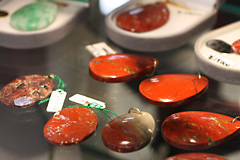 Sado Hoshoku is a workshop that works on the processing of noted stones on Sado. While processing craftsmen decreased in number with the change of the times, the founder of the store passed his competent processing techique down to his heir, who produces each work of art sitting face to face with the material.
Sado Hoshoku is a workshop that works on the processing of noted stones on Sado. While processing craftsmen decreased in number with the change of the times, the founder of the store passed his competent processing techique down to his heir, who produces each work of art sitting face to face with the material.
Around the 30th year of Showa, Sado Hoshoku gradually began to make such handiworks of noted stones as accessories, along with the processing of noted stones which were produced in abundance on the island. Now, by employing the skills it fostered through these works, it has become the only workshop on Sado where "handiworks of abalone shells" are made. Trying to put emphasis on completing high-quality works meticulously, Sado Hoshoku works so as to bring out the charms innate in the materials.
Handiworks of abalone shells
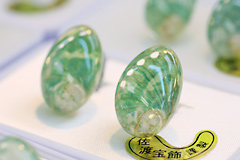 "Handiworks of abalone shells" are made out of the shells of infant abalones. Unlike the traditional technique called raden (the decorating technique using the lustrous part of the inside of the shell), the craftsmen employ a rare technique which shows the outside part of the shell.
"Handiworks of abalone shells" are made out of the shells of infant abalones. Unlike the traditional technique called raden (the decorating technique using the lustrous part of the inside of the shell), the craftsmen employ a rare technique which shows the outside part of the shell.
Sado Hoshoku started to work on handiworks of abalone shells in 1989, because the way of processing shells in which the outside part of the shell was shown was similar to the processing of noted stones, and because abalones were farmed in this locality. In additon to the processing of infant shells, this work calls for the skill in processing resin with which to coat the shells. At first Sado Hoshoku had to undergo a series of trials and errors, but now that it has acquired the techinique, the stable completion of the handiworks has been made possible. The light green color characteristic of abalone shells stems from the color of the feed (seaweeds) which abalones have eaten. No two abalone shells have the same tinge, and you can enjoy the distinctive natural color that each one has. Why don't try and look for your own favorite handiwork?
"Akadama-ishi," the noted stone of Sado
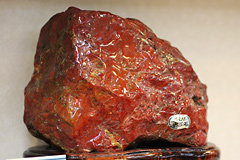 Besides the gold of Sado Gold Mine, the production of beautiful stones has made Sado unique, and the abundance in the varieties and production quantity of them has made the island nationally famous as the island of "Sado's red stones."
Besides the gold of Sado Gold Mine, the production of beautiful stones has made Sado unique, and the abundance in the varieties and production quantity of them has made the island nationally famous as the island of "Sado's red stones."
The red stones which can be seen at various places such as the entrances of private houses and facilities are called "Akadama-ishi," and recognized as one of Japan's three greatest noted stones (the chrysanthemum stone of Gifu, the kamuikotan of Hokkaido and the Akadama-ishi of Sado).
Sado's Akadama-ishi has been turned out in the Akadama area of the Ryotsu district, and is said to have been formed underground 20 million years ago. Because Akadama-ishi is very hard, the relics show that it was used for arrowheads and stoneware in the Jomon era, while in the Yayoi era it was used for such personal ornaments as kudatama. In addition to Akadama-ishi, the noted stones produced on Sado include goshikiseki, kinkoseki, raikoseki, jasper and agate. As a whole these stones are hard and similar in quality to agate, and the luster brought out by polishing and the beauy of patterns of flowing lines are characteristic of these stones.
More details
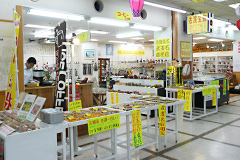
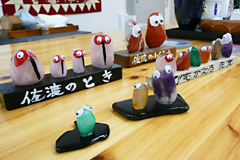
| name of facility | Sado Hoshoku |
|---|---|
| address | The 2nd floor of Ryotsu Minami-futo Building 353-1 Ryotsu-minato, Sado City, Niigata Prefecture |
| business hours | 9:00 - 16:00 |
| a regular holiday | The summer season (May - October) / Open daily The winter season (November - April) / Open daily except otherwise noticed |
| payment method | cash |
| commodities that are dealt in (sold) | Handiworks of abalone shells, handiworks of noted stones, and souvenirs of Sado (Mumyoi-yaki pottery and others) |